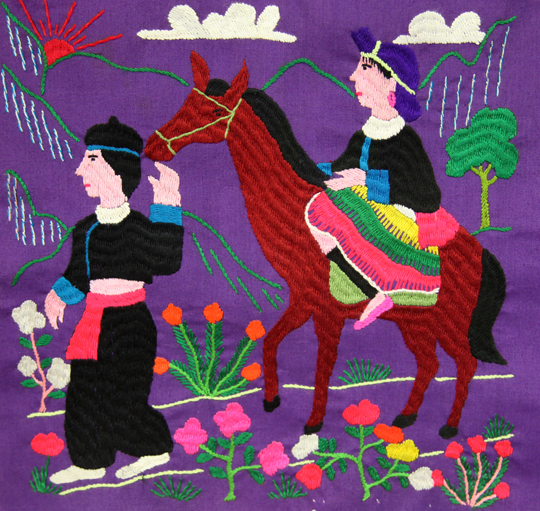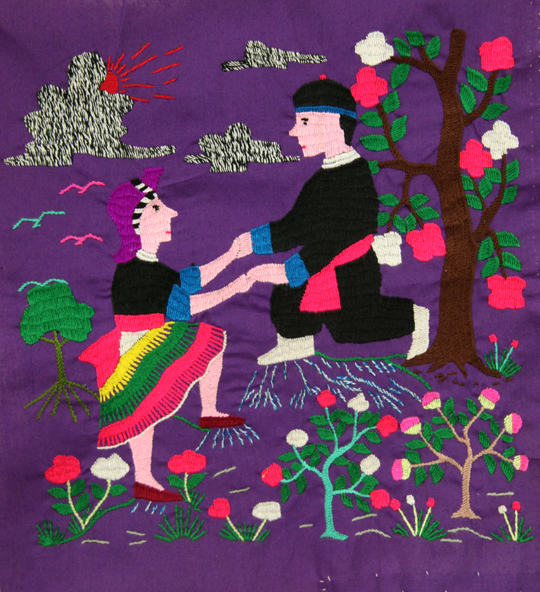Embroidery: Farming Village Life and the War Experience |
|---|
 |
EF11: This piece is embroidered with cross-stitches on brown monk’s cloth. The figures depicted on this embroidery are Green Hmong women, animals, insects, plants, and flowers. There is a cross-stitch frame of motifs that resemble fish hooks, the sign of a young woman looking for a mate, or ram’s heads, then appliquéd borders of blue, green, and brown.
|
Back to Top |
 |
EF12: This tapestry depicts the typical attire for White Hmong men and boys. The jacket and pants were usually black, and the jacket cuffs were blue. As seen in this tapestry, the boy is
By Yer Lo, 1980s, 31x30 cm |
Back to Top |
 |
EF13: The attire worn in this tapestry is characteristic of Green Hmong women. It involves a skirt that is usually black or indigo, and is decorated with bright red, green, blue, and yellow embroidery and appliqué. Surface stitching is used for the figure, done in cotton thread on cotton cloth. White and gray borders create a frame, as well as the triangles of the mountain motif that were created using appliqué.
By Yer Lo, 1980s, 31x30 cm |
Back to Top |
 |
EF14: This is an embroidered artwork depicting Green Hmong women. The skirt is a typical colorful Green Hmong skirt sewn in red, green, blue, and black. An apron is worn in front of the skirt and sewn to a red sash that is wrapped two or three times around the waist. Here, two Xieng Khouang girls are standing by a flowering plant. The technique used involved
By Cher Moua, Laos, 1998, 31x30 cm |
Back to Top |
 |
EF15: This is a tapestry depicting courting couples. The young men are playing the Qeej, a bamboo reed pipe that uniquely belongs to the Hmong people. It is considered an ancient musical instrument. The Qeej is used for entertainment and cultural purposes. The Qeej is played at community events, festivals, to welcome leaders and officials, and at funerals and weddings. It is more common to see the Qeej used in weddings among the Hmong in Vietnam, and China as opposed to Laos. The young women in this piece are dancing with their colorful umbrellas to the song of the Qeej. This embroidery was done by hand utilizing darning stitches. The frames were done in applique methods and serve as a frame.
By an unknown artist Photo by Xai S. Lor, item at the Hmong Cultural Center |
Back to Top |
 |
EF16: It is unusual to see a scene like this by itself. Normally in Hmong tapestry, a whole
By Tong Vang, Laos, 2010, 27x29 cm |
Back to Top |
 |
EF17: This tapestry piece involves a depiction of love. The couple shown in the tapestry is climbing up a mountain for the purpose of sightseeing. Unmarried Hmong couples often visit such places to view the beautiful scenery, and make promises pertaining to their love and |
Back to Top |
|
EF18: The figures presented in this tapestry are distorted and do not look like the figures
By Mee Lee Xiong, Laos, 2005, 25x28 cm |
Back to Top |
EF19: This embroidery storybook shows the village and farming life of the typical Hmong farming tapestry story cloth. The book features the English and Lao languages.
By Ziag Yaj, Laos, 2012, 14x17 cm |
Back to Top |
Page 1 << Page 2 |




